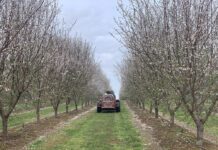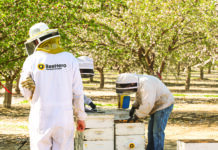
“Climate-smart agriculture.” While not common parlance under the tree canopy yet, many growers are increasingly adopting practices recognized as climate-smart because they make sense for improving soil quality or efficiency. Plus, there are more economic incentives to implement them today than ever before.
So, what is climate-smart agriculture? Basically, it’s any management practice that reduces greenhouse gas emissions or keeps them out of the atmosphere, also known as sequestration. This includes practices that use water and nitrogen efficiently, improvements to energy efficiency, and using renewable fuel or contributing to biofuels with co-products. However, most of the excitement is around sequestering carbon in the soil; that is, practices that build up and maintain higher levels of organic matter.
“If we had this conversation 30 years ago, I think people would agree on these practices; they’re just meant to be,” said Ben King, a Colusa-based almond grower, managing principal of Pacific Gold Agriculture, LLC and a member of the Almond Board of California’s (ABC) Bee Health and Pollination Workgroup. “Sustainability and climate-smart ag is about keeping your ground fertile for future generations. I don’t think we’re that far off between what we do and what’s being discussed.”
Agriculture as Part of the Climate Solution
With nearly 900 million acres of working lands across the U.S., agriculture is uniquely positioned to assist various initiatives aimed at curbing greenhouse gas emissions. This is due partly to the ability to sequester carbon in soil.
“A lot of food companies have figured out that climate change is a real risk to their business and they are stepping in, setting voluntary goals to reduce emissions from their operations,” said Gabriele Ludwig, ABC’s director of Sustainability and Environmental Affairs.
In 2020, General Mills announced it would reduce greenhouse gas emissions by 30% across its value chain over the next decade, while Hershey’s recently announced it would seek a 25% reduction by 2030. Nestlé aims for a 20% emissions reduction by 2025 and a 50% reduction by 2030, followed by achieving net-zero emissions by 2050.
“For food companies to meet their aggressive climate goals, they need help both upstream and downstream in their value chain,” Ludwig said. “Upstream would be from growers and downstream would be from things like food waste and recycling or reusing packaging.”
So, what does upstream help look like when it comes to climate-smart agriculture practices?
“The thinking is if there’s a focus on soil quality improvements through organic matter inputs, it not only benefits the environment, but also helps the grower,” Ludwig said. “The tangible agronomic benefits may be better water infiltration and/or increased water holding capacity in soils. Companies like these practices because they often provide co-benefits such as reduced erosion or movement of nitrogen.”
Examples of organic matter inputs in orchards include cover crops, composted manure or green-waste applications, chipping of prunings and whole orchard recycling. Recently completed research into whole orchard recycling from UC Davis showed an improvement in water holding capacity, the addition of nitrogen in the soil over time and a 19% cumulative nut yield increase over five years.
Other UC research has been looking at the impact of composted manure and green-waste to soils. Depending on the source of the compost, growers may be able to reduce applications of synthetic nitrogen by up to 20% due to increased water holding capacity. This helps keep nitrogen where roots have a greater chance to take it up, making nitrogen less likely to leach into groundwater.
Cover Crops: Climate-Smart Practice with Multiple Benefits
In Colusa, King has been a long-time advocate for the use of cover crops in and around almond orchards. He says their strategic use adds organic material to the soil, with the added benefit of providing much-needed habitat for wild and managed pollinators.
King planted cover crops in all 350 acres of his almond orchards this past year to reap the soil and pollinator benefits offered by the practice. As the cover crops grow, King welcomes all pollinators into his orchard, noting that “what’s good for a bumble bee is good for a honey bee; there’s not a bad pollinator.” After the cover crops have done their job of feeding pollinators, and soil microbes from their roots, it is mowed in the spring, where it will breakdown to return organic matter to the soil.
“We planted what’s called a soil builder, which has some mustard, legumes and some barley,” King said. “The stuff we planted earlier turned out pretty good, without much precipitation. Going into May, we had a stand that was about four feet high from just rain. I see the difference in the water holding capacity of my soils where I’ve had cover crops more regularly from year to year.”
To help with the cost of planting his cover crops, King leveraged the California Department of Food and Agriculture’s (CDFA) Healthy Soils Program, which provides financial incentives to farmers to implement various practices that sequester carbon. Since 2017, more than $9 million dollars has been awarded to almond-specific projects.
“The Healthy Soils Program covered my seed costs and some of the costs to plant it,” King said. “We need this kind of program at a much larger scale.”
Climate-Smart Ag: More than Organic Matter
According to an ABC-funded lifecycle assessment of California almonds, nitrogen and water use are the top two contributors to the almond industry’s carbon footprint (all of agriculture in California accounts for 8% of greenhouse gas emissions in the state.)
When synthetic nitrogen fertilizer arrives for use in an orchard, it brings with it a carbon footprint due to the fossil-fuel based energy used in its production. ABC’s Ludwig noted that growers have little control over that process; however, some fertilizer companies are working to decarbonize the energy used to produce nitrogen fertilizer, which may allow growers to choose lower carbon footprint fertilizers in the future.
Once applied, nitrogen can be converted by soil microbes to nitrous oxide, a greenhouse gas with a global warming potential nearly 300 times greater than carbon dioxide. However, practices that improve nitrogen use efficiency can also help reduce nitrous oxide emissions. For almonds, such practices include matching the amount of nitrogen applied (from both synthetic and organic sources) to projected yield, using April leaf sampling, applying nitrogen in more frequent and smaller amounts, and making sure the irrigation system is functioning as advertised to avoid over- or under-irrigation.
According to the almond lifecycle assessment, greenhouse gases associated with water are from the energy it takes for pumping it. That includes moving it around the state and into the orchard, pumping groundwater and/or pressurizing the water for microirrigation systems. Thus, efforts to ensure that pumps and irrigation systems are functioning efficiently are also climate-smart practices.
Another aspect is the form of energy used for pumping and pressurizing. Moving from diesel to electric motors reduces greenhouse gas emissions both by avoiding the use of fossil fuels and because the electricity used to run these pumps has a declining carbon footprint as a result of California’s implementation of its Renewables Portfolio Standard Program (SB 1078). This program mandates that 60% of the state’s electricity be generated from renewable sources by 2030. And some growers are even producing their own energy with solar panels.
Furthermore, there is a link between practices that increase soil organic matter and the energy used for irrigation. Research has indicated that increasing soil organic matter by 1% can increase soil-available water holding capacity by 3.7%. That increased water holding capacity can provide more flexibility as to when a grower irrigates, such as timing irrigation to match lower electrical rate schedules or when energy is supplied onsite by solar or wind. And in heavier soils, practices that improve water infiltration can help avoid runoff or needing to irrigate more frequently for short periods of time.
Getting Credit Where Credit is Due
The California Almond Sustainability Program (Casp) enters its 11th year of helping individual growers, handlers and the broader industry track and improve practices. Dr. Dan Sonke, Director of Sustainability at Blue Diamond Growers, is deeply familiar with CASP, having worked on the development of the program’s first five modules as a consultant at the program’s inception.
“CASP aligns very well with climate-smart ag practices,” said Sonke, who is also a member of the ABC Sustainability Workgroup. “There’s an interconnectedness you see in the CASP modules. When growers are asked about energy use, there are also questions about pesticide use because it takes energy to make pesticides. If you’re using integrated pest management practices to reduce pesticides, you’re reducing energy use, which has climate implications. CASP was designed to highlight the system-wide thinking that climate-smart agriculture requires.”
Handlers such as Blue Diamond Growers report that buyers increasingly ask about, and make decisions based on, environmental and sustainability issues. An important change in recent years is the request for data, rather than anecdotal accounts, to verify sustainability claims. Sonke says this is where CASP is critically important for the almond industry to stay relevant and ahead of the curve.
“To remain a nutritious ingredient or snack of choice, we want to have the data to prove the good story we have as an industry,” Sonke said. “We know we have a good story. We just need the data to document it so we can remind customers and consumers as to the goodness of almonds, not just from a nutrition and taste standpoint, but also a sustainability standpoint.”
Sonke shared that since CASP is such an integral tool to communicate the progress of its growers to its customers, Blue Diamond Growers made the recent announcement that it will provide financial incentives to growers to participate in the program. More information about CASP is available at SustainableAlmondGrowing.org.
Later this year, ABC will begin a pilot project with Ecosystem Services Market Consortium (ESMC), a non-profit that is developing carbon markets to link companies and growers. In addition to state and federal incentive programs, private partnerships will pay growers directly for implementing climate-smart practices such as using compost, whole orchard recycling, and/or cover crops. Growers interested in participating in the ABC-ESMC pilot project should contact ABC’s Gabriele Ludwig at GLudwig@almondboard.com.
Last, but not least, growing trees is climate smart! However, agricultural trees do not get credit for their greenhouse gas reductions for several reasons. One is that the inputs previously discussed (water and nitrogen) often have emissions associated with them. And for actual carbon markets, one of the key criteria is that practices must be “additional” for payment eligibility.
“It comes down to if trees are grown for a business benefit, society or companies will not pay a grower for that because that’s business as usual,” Ludwig said. “Practices that are credited or rewarded monetarily must be something above and beyond what a grower would normally do.”
References
UC Davis Whole Orchard Recycling, Biomass recycling for sustainability and resilience of almond production: http://orchardrecycling.ucdavis.edu/
2 Effect of Partial Fertilizer Substitution with Organic Matter Amendments on Nutrient Cycling,” Almond Board of California 2020 Research Update: http://www.almonds.com/sites/default/files/2020-12/ResearchUpdate_121620202.pdf#page=26
3 See California Pollinator Coalition article in this edition of How We Grow.
4 “Greenhouse Gas and Energy Footprint of California Almond Production” Kendall A, et al. (2015) J. of Industrial Ecology: http://sarep.ucdavis.edu/sites/g/files/dgvnsk5751/files/inline-files/kendall-lifecycleassessment-ghgemissionsforalmondp.pdf
5 Growers can use the free Nitrogen Calculator in the California Almond Sustainability Program (CASP): http://www.sustainablealmondgrowing.org/Home/ToolsBenefits/tabid/220/Default.aspx
6 “Nitrogen Best Management Practices” Almond Board of California (2020): http://www.almonds.com/almond-industry/orchard-management/soil-health-and-nutrients/nutrient-management
7 “Effects of Implementation of Soil Health Management Practices on Infiltration, Saturated Hydraulic Conductivity (Ksat), and Runoff” Smith C, et al. (2015): http://www.nrcs.usda.gov/wps/PA_NRCSConsumption/download?cid=nrcseprd1289235&ext=pdf















